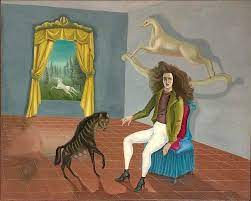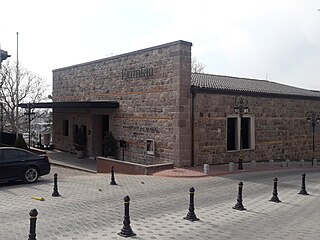
The Metropolitan Museum of Art in New York City, colloquially "the Met", is the largest art museum in the Americas. In 2022 it welcomed 3,208,832 visitors, ranking it the third most visited U.S museum, and eighth on the list of most-visited art museums in the world. Its permanent collection contains over two million works, divided among 17 curatorial departments. The main building at 1000 Fifth Avenue, along the Museum Mile on the eastern edge of Central Park on Manhattan's Upper East Side, is by area one of the world's largest art museums. The first portion of the approximately 2-million-square-foot (190,000 m2) building was built in 1880. A much smaller second location, The Cloisters at Fort Tryon Park in Upper Manhattan, contains an extensive collection of art, architecture, and artifacts from medieval Europe.

François Boucher was a French painter, draughtsman and etcher, who worked in the Rococo style. Boucher is known for his idyllic and voluptuous paintings on classical themes, decorative allegories, and pastoral scenes. He was perhaps the most celebrated painter and decorative artist of the 18th century.

A rhyton is a roughly conical container from which fluids were intended to be drunk or to be poured in some ceremony such as libation, or merely at table. A rhyton is typically formed in the shape of an animal's head. Items were produced over large areas of ancient Eurasia, especially from Persia to the Balkans. Many have an opening at the bottom through which the liquid fell; others did not, and were merely used as drinking cups, with the characteristic that they could not usually be set down on a surface without spilling their contents.

The Madonna and Child Enthroned with Saints, also known as the Colonna Altarpiece, is a painting by the Italian High Renaissance artist Raphael, executed c. 1503-1505. It is housed in the Metropolitan Museum of Art of New York City. It is the only altarpiece by Raphael in the United States.

The Achaemenid Persian Lion Rhyton is an ancient artifact related to Achaemenians.

Nude Before a Mirror is a 1955 painting by Polish-French artist Balthus.
Ancient Cypriot art refers to all works of visual art originating from Cyprus in the Eastern Mediterranean from c. 10,000 BC to c. 330 AD. During this period, various types of objects were produced such as domestic tools, weaponry, jewellery, and decorative figurines. This range of art attests to the blend of both native and foreign influences of ancient Egypt, Greece and Rome as they successively occupied the country. Artworks produced in ancient Cyprus incorporate almost all of the mediums of visual art worked on in ancient history including terracotta, stone, metals, glass, and gemstones.

The Afternoon Meal is a mid-eighteenth-century still life painting by Spanish painter Luis Egidio Meléndez (1716–1780).

Egyptian Woman with Earrings is a late 19th-century painting by American artist John Singer Sargent. Done in oil on canvas, the work portrays an Egyptian woman. The painting is in the collection of the Metropolitan Museum of Art in New York.

Ferry near Gorinchem is a mid 17th century painting by Dutch artist Salomon van Ruysdael. Done in oil on canvas, the work depicts a riverside embankment near Gorinchem in the Netherlands; in addition, the painting also depicts the prominent St Jan's Tower of the Grote Kerk, the town's church. Ruysdael's rendering of the land near Gorinchem was possibly impacted due to the artist's owning of a mill on the river. The work is in the collection of the Metropolitan Museum of Art.

Cypresses is a late 19th-century painting by Dutch artist Vincent van Gogh painted around June 1889. Done in oil on canvas, the painting depicts a pair of cypress trees in the French countryside. The work is currently on display in the Metropolitan Museum of Art.

The Dream of Aeneas is an oil-on-canvas painting by Italian artist Salvator Rosa, executed c. 1660–1665. It depicts a scene from the Roman poet Virgil's Aeneid in which an embodiment of the Tiber river speaks to the Trojan hero Aeneas. The work is in the collection of the Metropolitan Museum of Art, in New York.

Self-Portrait is a painting executed by artist Leonora Carrington and is currently in the collection of the Metropolitan Museum of Art. She began the painting in London in 1937 and completed it in Paris in 1938. It is one of her most recognized works and has been called her "first truly Surrealist work." The presence of horses and Hyenas soon became a common feature in her work.

Erimtan Archaeology and Arts Museum is an archaeology museum and music venue in Ankara, Turkey.

Girl with a Cat is a portrait painting by Gwen John in the collection of the Metropolitan Museum of Art.

Lobster Fishermen is an early 20th century painting by American artist Marsden Hartley. Done in oil on masonite, it depicts a group of lobster fishermen in Hartley's native state of Maine. Considered part of Hartley's 'Maine Series', it is in the collection of the Metropolitan Museum of Art.

Indian Vase, 1876 by Ames Van Wart. Marble, 46 1/2 x 24 x 16 in.. The Metropolitan Museum of Art, New York, Gift of Estate of Marshall O. Roberts, 1897 (97.10). On view in gallery 760. From the Met’s website: “Its motifs explicitly acknowledge the displacement of Indigenous Americans by Euro-American settlement in the West”.

Sibylle is an oil-on-canvas painting created c. 1870 by the French artist Jean-Baptiste-Camille Corot. It depicts a model holding a red rose. The painting is in the collection of the Metropolitan Museum of Art, in New York.

















